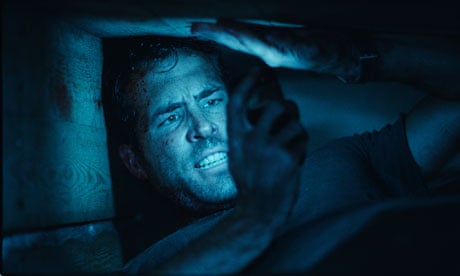Some worry that mobile phones, by abolishing isolation and jeopardy, are killing off the modern thriller, or at least slowing it down with the obligatory, laborious dialogue: "No signal!" – "Whaddaya mean no signal?" – "I mean I can't get a signal!" etc. Well, here's a new thriller that couldn't have existed in the pre-cellphone age. This extraordinary high-concept, high-anxiety, low-budget nightmare from Spanish director Rodrigo Cortés is guaranteed to give everyone suffering claustrophobia a permanent nervous breakdown. In fact, it's guaranteed to give everyone permanent claustrophobia. Ryan Reynolds stars as Paul Conroy, an ordinary guy who wakes up as the film starts, after some long, long seconds of total blackness, buried alive in a wooden coffin. And that is where he and we stay for the entire film: in that tiny eight-by-eight wooden box. By the end, I was quietly wheezing and whinnying with distress.
All Paul apparently has to light up the darkness is the flame of his Zippo, and the screen-glow of a mobile phone, with which his abductors have provided him. He is buried just shallowly enough to get a signal, and he must use this phone to communicate both with his sadistic jailers and with possible rescuers. But his oxygen and his phone battery are gradually running very low; Paul must not panic as hyper-ventilation will burn up the air quicker and he is already on medication for stress.
What becomes clear in the opening few minutes is that Paul is a civilian contractor in Iraq, a fact which solves some mysteries, but opens the way for many more. With desperate, trembling fingers, Paul manages to call a government department, and, identifying himself as a US citizen, screams for help. But the smooth, calming person he hears, evidently liaising with coalition forces, is a Brit. Why a Brit? Could it be that Cortés wishes to remind us of America's most loyal ally? And that this tactful Brit is not, perhaps, entirely truthful in all that he's saying?
As a satirical image of America's involvement in Iraq – resentful, oppressed, panicky – Buried could hardly be improved upon. Something in the movie also put me in mind of the grim case of David Bloom, a journalist "embedded" with US troops who died on the battlefield in 2003 of deep vein thrombosis, after staying immobile in a cramped army vehicle. The way Cortés and writer Chris Sparling control the twists and turns is tremendously assured, and the suspense is unbearable right to the very end. Paul's phone calls to his family are heartrending, and his lengthy conversation with his employer is a black-comic setpiece of pure horror.
It might all sound like a radio play, but the stark, ghostly image of Ryan Reynolds's anguished face is gripping. I was reminded of something David Hare wrote in a booklet on film-making given away in this paper last Saturday: the screenwriter's maxim should be Tell, Don't Show, because the crises in our lives are always defined by speech. Sparling's dialogue is terrific. If you can take the sheer, asphyxiating, chest-crushing terror, then this is for you.

Comments (…)
Sign in or create your Guardian account to join the discussion